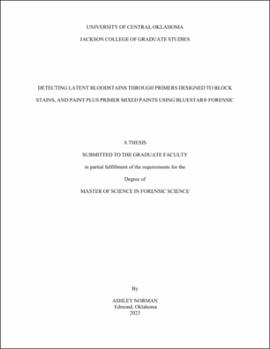| dc.contributor.advisor | Adams, Dwight | |
| dc.contributor.author | Norman, Ashley | |
| dc.date.accessioned | 2023-06-26T15:35:39Z | |
| dc.date.available | 2023-06-26T15:35:39Z | |
| dc.date.issued | 2023 | |
| dc.identifier.other | (AlmaMMSId)9982957508002196 | |
| dc.identifier.uri | https://hdl.handle.net/11244/337831 | |
| dc.description.abstract | This study was conducted to determine if a paint plus primer or a primer designed specifically to block stains would affect the efficacy of Bluestar® Forensic, a blood enhancement reagent, through varying layers of paint. Very little research has been done on Bluestar® Forensic within the forensic science community, meaning research into its limitations is still in its infancy. This study focused on a dark colour vs a light colour, spatter vs swipe patterns, and four different brands of paint. Sixteen two-foot by two-foot pieces of sheetrock were purchased and sorted into two equal groups. Eight of them were used for swipe pattern testing and eight were used for spatter pattern testing. Within each group of eight, two pieces of sheetrock were put together to create a two-foot by four-foot panel. Each piece of sheetrock was split into one-foot by one-foot sections. Each row was assigned a different paint and or primer. Starting at the left, the first one-foot by one-foot square was split into two control squares, and then in each square from left to right thereafter, each paint was applied with one layer, then three layers, then five layers. Ultimately, there was one two-foot by four-foot panel for light coloured paint plus primer, one two-foot by four-foot panel for dark coloured paint plus primer, one two-foot by four-foot panel for light coloured stain blocking primer, and one two-foot by four-foot panel for dark coloured stain blocking primer for each pattern tested (spatter and swipe) for a total of eight two-foot by four-foot panels. The goal of this study was to determine the limitations of Bluestar® Forensic using commonly available paints and/or primers found in any local hardware store. This study found that visually, the dark colour was more effective in concealing bloodstains. The paint plus primers were visually less effective than the stain blocking primers when using a light colour. The concentration of blood applied to the surface, via swipe over spatter, did make a difference in Bluestar®'s ability to detect the hidden bloodstains with the lighter colour. | |
| dc.rights | All rights reserved by the author, who has granted UCO Chambers Library the non-exclusive right to share this material in its online repositories. Contact UCO Chambers Library's Digital Initiatives Working Group at diwg@uco.edu for the permission policy on the use, reproduction or distribution of this material. | |
| dc.subject.lcsh | Bloodstains--Analysis | |
| dc.subject.lcsh | Chemical tests and reagents | |
| dc.subject.lcsh | Primers (Coating) | |
| dc.subject.lcsh | Paint | |
| dc.subject.lcsh | Forensic hematology | |
| dc.title | Detecting latent bloodstains through primers designed to block stains, and paint plus primer mixed paints using Bluestar® Forensic | en_US |
| dc.type | Academic theses | |
| dc.contributor.committeeMember | Gravel, Craig | |
| dc.contributor.committeeMember | Mabry, John | |
| dc.contributor.committeeMember | Kress, Austin | |
| dc.thesis.degree | M.S., Forensic Science | |
| dc.subject.keywords | Bloodstains | |
| dc.subject.keywords | Bluestar Forensic | |
| dc.subject.keywords | Paint | |
| dc.identifier.oclc | (OCoLC)1385982450 | |
| thesis.degree.grantor | Jackson College of Graduate Studies | |
